Organ vs Harpsichord: More Than Just Black and White Keys
Most people think the organ vs harpsichord question is simple: they’re just old-timey pianos, right? They lump all baroque keyboard instruments together, seeing keyboards in fancy wooden boxes. But that’s where the similarity ends. In reality, they are as different as a flute is from a guitar.
Understanding this key difference between organ and harpsichord changes how you hear hundreds of years of music.
We’ll break down exactly how each one works, what they feel like to play, and why one became the grand voice of cathedrals while the other was the heartbeat of smaller musical gatherings.
You’ll soon be able to tell them apart just by listening and get why composers like Bach are still famous for mastering both of these incredible instruments, marking a key point in the evolution of keyboard instruments.
How Do They Actually Make Sound?
This is the most important question, and its answer reveals what makes each instrument unique. While both use a keyboard, what happens after you press a key is what defines the entire organ vs harpsichord difference.
Both are fantastic examples of mechanical action keyboards, but their mechanics are worlds apart.
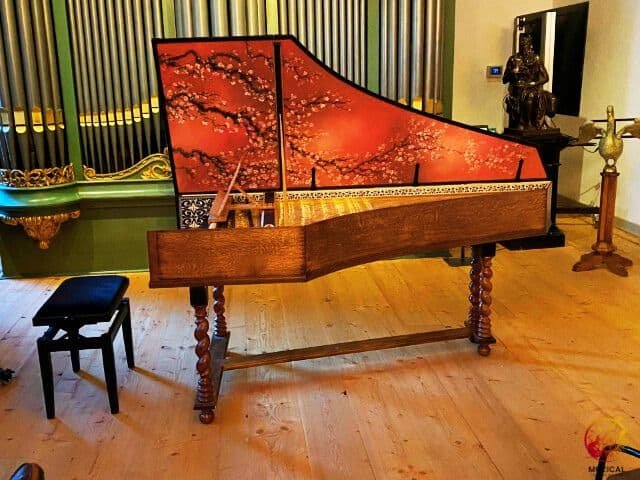
Harpsichord
The harpsichord is a string instrument. The easiest way to picture it is as a mechanical guitar played with keys. Inside the case, strings are stretched tight over a soundboard. When you press a key, it pushes up a small wooden piece called a “jack.”
At the top of the jack is a tiny plectrum, originally made from a tough bird’s quill, that plucks the string. This creates a bright, twangy, and crisp sound. When you let the key go, a small felt pad drops onto the string to stop the sound.
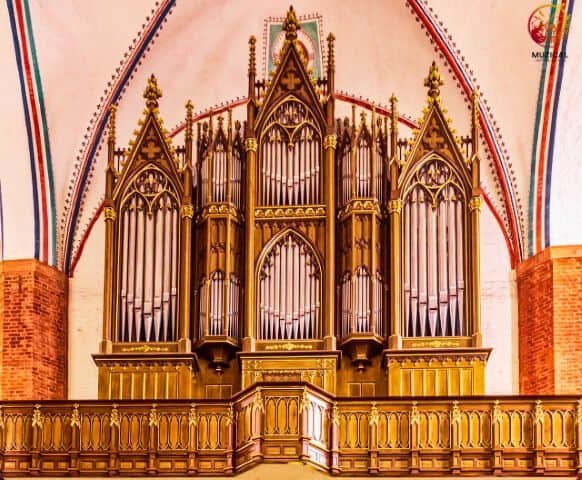
Organ
On the other hand, the organ is a wind instrument. Think of it as a huge collection of special whistles, called pipes. It has no strings at all. When you press a key, a valve opens and lets a stream of air flow into a pipe, which makes the sound. You aren’t hearing a string being plucked; you’re hearing the sound of moving air. The huge number and variety of these pipes are what give the organ its powerful, rich sound.
| Feature | Harpsichord | Pipe Organ |
|---|---|---|
| Instrument Family | Chordophone (String) | Aerophone (Wind) |
| Sound Source | Metal strings | Metal or wooden pipes |
| Sound Activation | A plectrum (quill) plucks a string | Pressurized air enters a pipe |
| Core Mechanism | Key -> Lever -> Jack -> Plectrum | Key -> Valve -> Wind Chest -> Pipe |
| Analogy | A mechanical harp or guitar | A collection of automated flutes |
So, the real comparison isn’t about two keyboards. It’s about the fundamental plucked vs wind keyboard sound. This single mechanical difference is the key to understanding all their other unique qualities.
Can You Control Volume and Expression?
If you’ve played a modern piano, you know that pressing a key harder makes the sound louder. This is key for playing with feeling. This brings us to a major point in the organ vs harpsichord debate, because neither of them works that way at all.
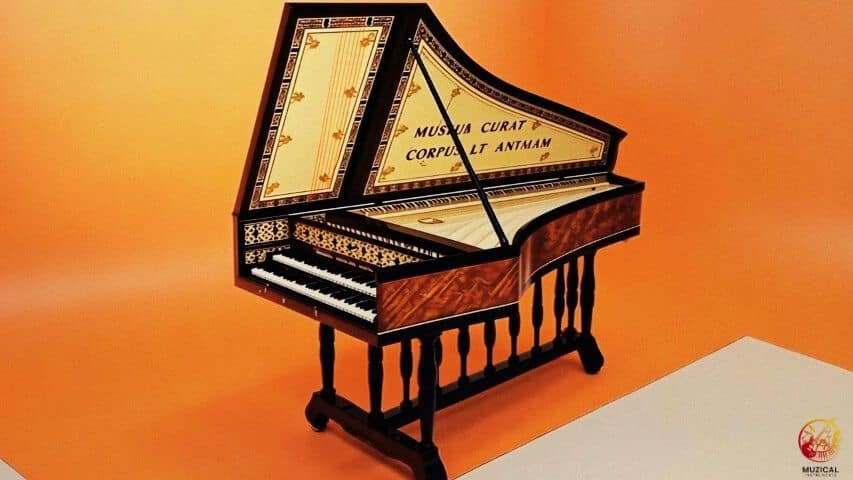
Harpsichord
A harpsichord has one set volume. It doesn’t matter if you tap a key or press it firmly; the string gets plucked with the same amount of force every time. So how do players show expression? It’s all about timing and decoration. They make the music interesting by connecting notes smoothly or playing them short and choppy. They also add little flourishes like trills.
Some larger harpsichords have two keyboards, where one can be made louder than the other, allowing the player to switch between a “soft” and “loud” level.
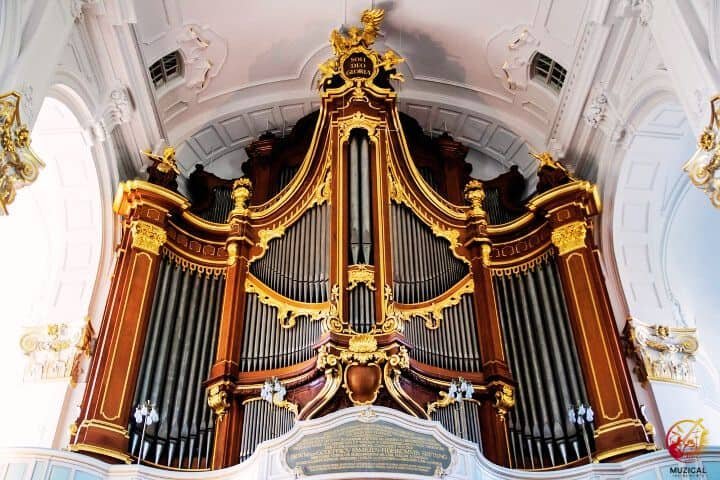
Organ
The organ is similar in that pressing a key harder won’t make a pipe play louder. However, the organist has a huge box of tricks for controlling volume. The main tools are the knobs called “stops.”
Each stop turns on a whole new set of pipes. To get louder, the player pulls out more stops, adding hundreds or even thousands of pipes to the sound. This is how an organ can go from a quiet hum to a room-shaking roar.
Many organs also have a foot pedal, called a “swell pedal.” This pedal opens and closes shutters around a box of pipes, making the sound gradually get louder or softer.
Expert Insight: How to Seem Louder on a Harpsichord
A common trick for harpsichordists is to make a note or chord feel more important without changing the volume. They might quickly roll the notes of a chord instead of playing them all at once, or add a quick decorative trill. This little burst of activity tricks your ear into paying more attention, giving the moment more weight.
What Was the Historical Role of the Organ vs Harpsichord?
Because they make sound in such different ways, these early music instruments were used for completely different kinds of music. Think of it like this: the organ was the voice of the church, while the harpsichord was the life of the party.
Organ
The organ has been around for ages and is famous for its connection to churches. Its sound is massive and can hold notes for a very long time, which was perfect for filling up huge, echoey cathedrals. The traditional use of organ in sacred music made it one of the most important church music instruments ever created.
It was loud enough to lead hundreds of people singing hymns and could create a powerful, spiritual feeling. Composers like the great J.S. Bach wrote deep and complex music for the organ that took full advantage of its grand sound.
Harpsichord
The harpsichord, however, was the go to instrument for music outside of the church, especially in renaissance and baroque music. Its sound is much quieter, with a crisp, clear pluck that worked best in smaller rooms like the parlors and halls of a palace or wealthy home. In a small orchestra, it was the backbone, playing the chords and bass line that held the group together. This solidified the role of the harpsichord in chamber music. Its world was social and for entertainment.
| Aspect | Organ | Harpsichord |
|---|---|---|
| Primary Domain | Church, Cathedral, Concert Hall | Chamber, Salon, Court, Orchestra |
| Musical Role | Liturgical support, congregational accompaniment | Basso continuo, solo instrument, chamber music partner |
| Aura & Association | Sacred, grand, powerful, divine | Secular, intimate, rhythmic, aristocratic |
| Key Composers | J.S. Bach, D. Buxtehude, C. Franck | D. Scarlatti, F. Couperin, J.P. Rameau |
| Era of Dominance | Middle Ages through Baroque, plus revivals | Renaissance through Baroque (c. 1500–1775) |
Which Instrument Is More Difficult to Learn?
So, which one is harder to play? That’s a classic question in organ vs harpsichord the historical keyboard comparison. The honest answer is that they’re both difficult, just in completely different ways. What you find hard as a musician will determine which one feels tougher to you.
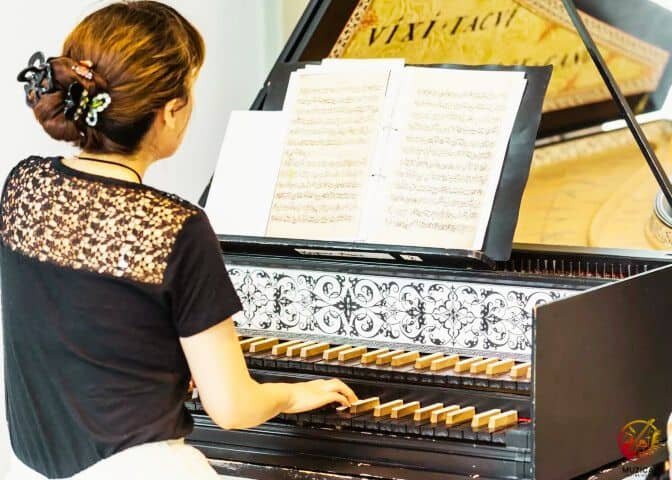
Harpsichord
The main challenge with the harpsichord is that you have to be incredibly precise. Because you can’t use volume to make the music more expressive, everything depends on your touch.
You have to control exactly when each note starts and ends to make the music flow and have personality. If your playing is messy, the music will sound muddy. But if you’re too mechanical, it can sound like a typewriter. The skill is all in your fingers.
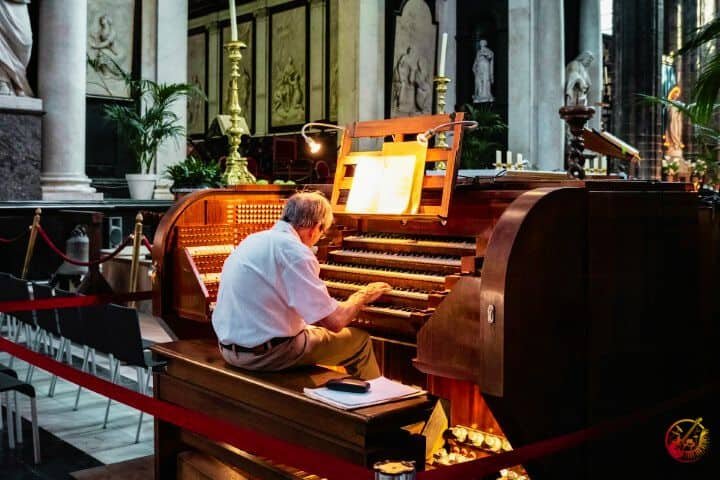
Organ
The organ, on the other hand, is a full body workout. The biggest challenge is coordination. An organist plays with their right hand, their left hand, and their feet on a whole keyboard of pedals all at the same time. It’s a level of multitasking that few other instruments require.
On top of that, you have to be an expert at the machine itself, knowing which “stops” to pull to change the sounds, often in the middle of playing a fast song.
Pro Tip for Piano Players
If you’re a pianist wondering which to try, think about your strengths. If you have clean, quick fingers and love making melodies sound perfect, the harpsichord might feel natural to you. If you’re good at doing many things at once and are excited by the idea of building huge sounds, the organ offers a whole world to explore.
How Do Composers Write Differently for Each Instrument?
You can really see the difference between these instruments just by looking at the sheet music. The notes on the page for an organ vs harpsichord tell two totally different stories, because composers had to play by two different sets of rules.
Organ
With the organ, you’ve got this amazing superpower: a note can last forever. So, what did composers do? They went wild with it! They wrote long, soaring melody lines that could float through a huge cathedral.
It’s also why you get those complex pieces where it sounds like four songs are playing at once, the organ can keep every part separate and clear. This is why so many of Johann Sebastian Bach keyboard works for the organ sound so monumental.
Harpsichord
But you can’t do any of that on a harpsichord. The sound from a plucked string vanishes in a flash. Composers had to be clever. To keep the music feeling alive, they packed it with fast notes, bouncy rhythms, and chords that ripple and cascade. Those little trills and frills you hear? They weren’t just for decoration; they were a trick to make a note linger for an extra split second. It’s music that’s all about energy, speed, and showing off how nimble a player’s fingers can be.
| Musical Element | Typical in Organ Music | Typical in Harpsichord Music |
|---|---|---|
| Melody | Long, sustained, legato lines | Rhythmic, highly ornamented, often broken into faster notes |
| Harmony | Dense, powerful, slow-moving chords | Clear, arpeggiated chords; realized from basso continuo |
| Rhythm | Often majestic and steady; can be complex but less percussive | Driving, vital, and percussive; rhythm is a key expressive tool |
| Texture | Thick polyphony, grand homophony | Transparent counterpoint, rapid passagework |
| Bass Line | Independent, powerful bass played by the feet | Played by the left hand, often as part of the continuo |
Final Thoughts
So, the whole organ vs harpsichord thing really boils down to air vs strings. The organ sings with a powerful, lasting breath of wind, while the harpsichord speaks with a sharp, rhythmic pluck. They aren’t just clunky old pianos; they’re two totally different classical music instruments, each with its own unique voice and personality.
The best way to truly feel the difference is to listen. Find a recording of some Bach played on a harpsichord, then listen to one of his massive organ pieces. The contrast will hit you right away.
Even better, try to hear them live. Many churches have organs you can hear during services, and sometimes music schools have concerts. Hearing these amazing instruments in person is the best way to get why they’re still so special today.
If you enjoy diving into keyboard differences, the Spinet vs Console piano comparison also shows how small design shifts can impact your playing style.
FAQ: Organ vs Harpsichord
1. What’s the absolute main difference between an organ and a harpsichord?
The simplest answer is how they make sound. The organ is a wind instrument; it blows air through pipes to create sound, like a collection of whistles. The harpsichord is a string instrument; it plucks metal strings with a small plectrum (like a guitar pick) to make its sound. One is breath, the other is a pluck.
2. Which instrument is older?
The organ is much, much older. Its earliest ancestors date back over 2,000 years to ancient Greece. The harpsichord is a youngster by comparison, first appearing in Europe in the late Middle Ages, around the 14th or 15th century.
3. Why did the piano become more popular than the harpsichord?
In a word: volume. The piano, invented in the early 1700s, could play notes loud or soft depending on how hard you pressed the keys. The harpsichord couldn’t do this. As musical styles changed, composers and audiences wanted that emotional, dynamic range, so the piano took over as the primary keyboard instrument for the home and concert hall. The organ survived because its role in the church and its sheer power couldn’t be matched by a piano.
4. Did Bach have a favorite instrument?
That’s the million-dollar question for music lovers! While he was a world-famous organist and held prestigious church jobs his whole life, he also wrote some of the most groundbreaking and essential music ever created for the harpsichord. He never wrote in a diary which one he preferred, so it’s safest to say he was a true master of both who knew exactly how to make each instrument shine in its own unique way.
5. Where can I hear these instruments live?
Hearing them in person is the best way to understand them! For pipe organs, larger and older churches are your best bet. A great place to start would be attending a service at a cathedral or historic church. For the harpsichord, which is rarer, keep an eye on the schedules for the music departments at local universities or see if any chamber orchestras are performing a program of Baroque music, as they often feature a harpsichord for an authentic sound.
